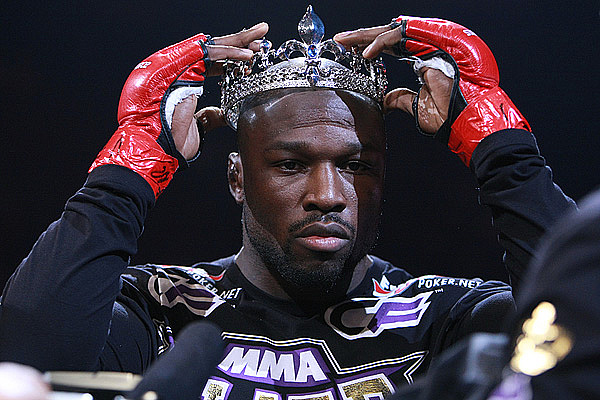King Mo and His MMA Identity
Perception vs. Reality

Muhammed “King Mo” Lawal has established himself as one of MMA’s
best showmen. | Photo: Dave Mandel
When a mixed martial artist comes out for his first fight dancing to the ring while wearing a crown, cape and medallion and surrounded by a parade of scantily clad women, including his personal umbrella carrier, it tends to make a certain impression on fans. Muhammed Lawal became a star practically overnight because he recognized MMA was show business, but that fame became a blessing and a curse.
In the world of professional wrestling, the vast majority of fans have come to recognize the distinction between the character a performer plays in front of the camera and the human being that plays that role. It is a world Lawal grew up following closely and a world he still aspires to be involved in at the end of his MMA career. He has modeled much of his public persona off the sort of larger-than-life characters that inhabit professional wrestling storylines.
Advertisement
“He’s so quiet,” longtime friend Daniel Cormier says of the Lawal he knows behind the scenes. “When he gets to know you, he’s laid back and cool, but if you don’t know Mo, he’s real quiet. I can’t believe it’s the same guy out there dancing with the cape. When he gets done training, he just gets on the computer and watches old YouTube wrestling matches all night or plays Mario Party on the Wii.”
Cormier and Lawal are close friends and have trained together as
wrestlers and mixed martial artists since 1998. They have taken
similar approaches in their training, working hard to improve their
standup and submission games while maintaining their elite
wrestling capabilities. However, they have adopted completely
different methods in terms of promoting themselves. Cormier took
lower-profile fights and did not seek out attention while he was
learning the game. Lawal went for the gusto. It paid off with big
fights and big money, accompanied by big-time scrutiny.
“
I get boos and this and
that. They say I’m cocky.
What do you expect
me to be? I train my ass off.
I don’t disrespect anybody.
”
When Lawal broke into MMA three years ago, he was tired of being broke. He sacrificed for years to pursue his dream of wrestling in the Olympics but fell just short of making the 2008 games. He holds a win over the gold medalist in his weight class from those games, Georgian Revaz Mindorashvili, but never had the chance to compete against him on the sport’s biggest stage.
Setting his sights on MMA, Lawal dove in headfirst. He had only trained for a month before his first fight against well-traveled UFC veteran Travis Wiuff -- who was named as his opponent just a week before the event -- at Sengoku “Fifth Battle” in Japan. The situation repeated itself in his next appearance against Fabio Silva a month later. Lawal was on an accelerated career path, and he knew what he had to do to market himself and further his career.
“MMA fans don’t get it,” Lawal says. “They talk bad about me or Chael [Sonnen], but if everyone’s the same, how do you draw interest into the sport? If I say, ‘You’re a great guy, a great fighter, a great dresser,’ nobody is going to care to watch the fight, but if you talk trash, people think you are going to go at it hard with this guy. They don’t get the difference between hype and sport.”
Of course, a paradox exists in what Lawal says. Hype intended to draw fans into a fight is not effective if they recognize it as simple hype. If a fighter makes an impression strong enough to get them to pay to see his fight, they are unlikely to easily discard that impression when the fight ends. The persona cannot easily be shed, no matter how unreal it may be. As a result, Lawal finds himself at odds with many fans that dislike him more for who he is perceived to be than who he actually is. This is the flipside of the meteoric rise of King Mo, from anonymity to CBS-televised title fight in less than two years.
“I get boos and this and that,” the 30-year-old Murfreesboro, Tenn., native admits. “They say I’m cocky. What do you expect me to be? I train my ass off. I don’t disrespect anybody. I don’t fight for them. I fight for myself, my family and for the money. MMA’s a job. I don’t give a damn what fans think. Most MMA fans can’t relate to me on any level; they just like MMA, and I kind of like MMA. I’m more of a boxing fan, but whatever. They can’t relate to me. If they could relate to me, they wouldn’t boo.”
Finish Reading » “People say I’m out of shape, but I want to see them go five rounds early in their career.”
Related Articles







